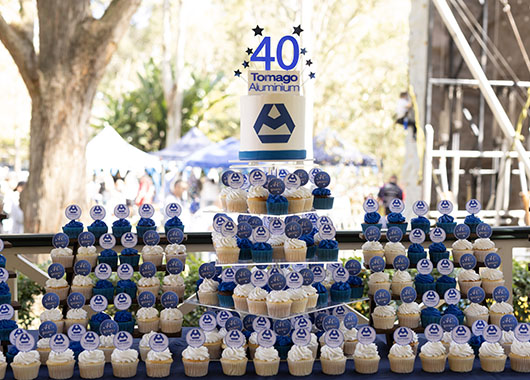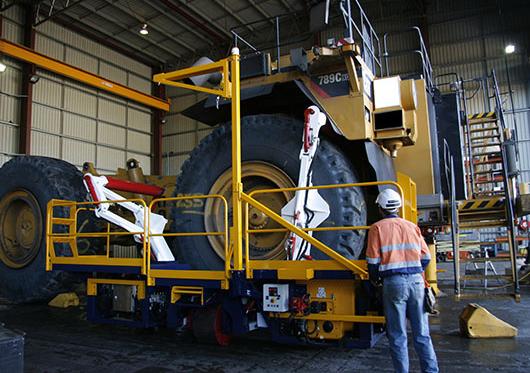Tomago Aluminium celebrates 40 years of operation

Tomago Aluminium Company is celebrating 40 years of operation at its 500-hectare site near Newcastle.
Interim CEO, Nigel Backhouse said the company has grown to become Australia’s largest aluminium smelter, a significant local employer and contributor to the Hunter’s economy and communities.
Mr Backhouse said the smelter has operated non-stop since it produced its first aluminium in September 1983. From an initial 240,000 tonnes of capacity, it now produces around 600,000 tonnes or 37 per cent of Australia’s primary aluminium annually.
“Tomago Aluminium’s success is due to its workforce, culture and significant investment in new and changing technology,” Mr Backhouse said.
“We established the smelter using the world's first large-scale AS18 technology. We continue to invest in world-class technology to help maintain our international competitiveness,” he said.
“We strive to be an employer of choice and have provided great stability and employment conditions for 4,902 employees over the four decades.
“We have always looked after our local community and in the past 25 years alone, the company and employees have donated more than $3 million to local charities.”
On Sunday, September 10, more than 900 employees and their families gathered at the Hunter Botanic Gardens for a 40th birthday party picnic. As well as live music, activities and food, there were bus tours of the smelter and a display of big mobile equipment to give the family members a behind-the-scenes look. A raffle and branded kid’s PPE raised over $6600 for Variety, the children’s charity.
Ten staff have worked at the smelter for the entire 40 years. Two of those staff members – Phillip Humphreys and Ross McCrohon - have served for 41 years because of their involvement in early work to establish the smelter.
The smelter was started through a partnership between French firm Pechiney, and Australian company Colonial Sugar Refining (CSR). Today, it is an independently-managed joint venture between Rio Tinto Alcan Primary Metals, CSR and Hydro Aluminium.
Aluminium is produced using three large potlines and 840 pots. It is Australia’s fifth-largest export commodity. Around 90 per cent of Tomago Aluminium’s product is exported to the Asia Pacific. Of the $2.2 billion the smelter contributes to the Australian economy annually, $800,000 is spent in the Hunter. It directly employs more than 1,000 people and indirectly supports more than 5,000 contractors, suppliers and their families.
Looking ahead, Mr Backhouse said Tomago Aluminium is moving to a low-carbon future and is aspiring to achieve net-zero operations by 2050.
“Our renewable investments will make a significant contribution to the Hunter region’s move to becoming a centre for renewable energy.”
Tomago Aluminium’s 40 years
- April 1980 - Tomago Aluminium participant signing
- 1981 – Construction starts
- March 1982 – Intake of first 25 apprentices including 7 women
- September 1983 – First production of aluminium when the first Pot came into operation.
- October 1983 – First export of 1500 tonnes of tee-ingots to Japan
- March 1984 – Official opening by the NSW Premier, The Hon Neville Wran
- December 1984 – Plant in full operation with two potlines
- March 1985 - Tomago House acquired
- November 1986 – Tomago House donated to the National Trust
- November 1992 – Third Potline starts; production capacity increases to 530,000 tonnes per year
- December 1998 - Extension of Potlines 1 and 2 complete
- 2001 - $200 million conversion to AP22 technology.
- 2009 - Production capacity increases to 575,000 tonnes per year.
- 2015 – Production capacity increases to 585,000 tonnes per year.
- 2016 - Production capacity increases to 600,000 tonnes per year.
- September 2022 – Outlines its decarbonisation strategy and net-zero ambition. Calls for Expressions of Interest from partners to shape its renewable energy transformation.
Other Articles from this issue
HMA announces 2023 finalists and presentation night
Mid-September put a spring in the step of Hunter manufacturing. Prime Minister Anthony Albanese visited Varley Engineeri...


Official launch of the Newcastle APS Academy Campus at University of Newcastle
On 5 July Senator the Hon Katy Gallagher, Minister for Finance, Women and the Public Service, launched the first Austral...




